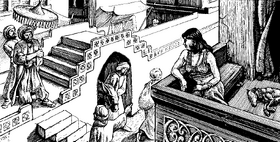
A drudach wall in the city of Calimport.
A drudach was the smallest subdivision of a Calishite town or city, roughly equivalent to a precinct or neighborhood.[1]
Description[]

An example sabban/drudach layout.
In cities, each drudach was surrounded by a short wall. This was usually constructed of mud bricks and was six feet wide and three feet tall.[1] (In Calimport, the drudach walls were twice as wide.[2]) In smaller towns, the drudach boundaries were marked by other means, such as rows of stones or wooden fences. In the cities, the drudach walls were used as walkways for the upper class residents, so that their feet would never have to touch the dirt of the ground. Doors from upper class houses opened directly onto the drudach walls, and archways crossed over the gates from one drudach to another.[1]
Every drudach contained at minimum the following structures:[1][3]
- a well, fountain, or other source of drinking water or a place of refreshment/entertainment, such as an inn, tavern, or festhall,
- a shrine, temple, or other religious site,
- a bazaar or khanduq or an administrative/government building for the town or city,
- a service building, such as smithies or guildhouses,
- the villa of the druzir, and
- an amlakkhan for housing the city guard/watch.
Most drudachs contained clusters of residential buildings numbering 16 to 25 buildings per cluster. These clusters tended to be constructed at the corners of the drudach boundaries, (as was the amlakkhan,) and made use of the structure of the drudach walls if present.[1][3] On average, about 500 people lived in each drudach.[4]
The center of a drudach was usually its richest area and often contained an open courtyard for its market, well, or fountain.[1]
Three to five drudachs together formed a sabban, a walled segment of a city that shared common resources among its subsections. It was possible for a small town to only contain a single sabban or even for a village to be composed of a single drudach.[1]
Government[]
The ruler of a drudach—at least in name—was called a druzir. Calimshan had no stipulations separating governmental powers or for limiting conflicts of interest, so the druzir of a military drudach might also be a military officer, the druzir of a religious drudach might also be a high priest, or the druzir of a merchant drudach a pasha (guildmaster).[4]
After the fall of the Shoon Imperium, the title of druzir lost most of its actual power, and true control of the drudachs passed to the hands of the pashas. However, when Ralan el Pesarkhal rose to power in Calimshan in 1359 DR, he returned control of drudachs to the druzirs.[4]
A druzir was responsible for overseeing trade, collecting taxes, and ensuring the safety and prosperity of the drudach's citizens.[4]
Defense[]
Each drudach was assigned a number of amlakkar to see to its defense and the maintainance of law and order. The commanding officers of the amlakkar reported primarily to the sultan of the town or city and only secondarily to the druzir.[5]
History[]
The drudach system was established in ancient past by the genies who once ruled Calimshan. The arrangement had changed little over the millennia of that country's existence.[1]
References[]
- ↑ 1.0 1.1 1.2 1.3 1.4 1.5 1.6 1.7 Steven E. Schend, Dale Donovan (September 1998). Empires of the Shining Sea. Edited by Julia Martin. (TSR, Inc.), p. 99. ISBN 0-7869-1237-5.
- ↑ Steven E. Schend (October 1998). Calimport. (TSR, Inc), p. 4. ISBN 0-7869-1238-3.
- ↑ 3.0 3.1 Steven E. Schend (October 1998). Calimport. (TSR, Inc), pp. 9–10. ISBN 0-7869-1238-3.
- ↑ 4.0 4.1 4.2 4.3 Steven E. Schend, Dale Donovan (September 1998). Empires of the Shining Sea. Edited by Julia Martin. (TSR, Inc.), p. 66. ISBN 0-7869-1237-5.
- ↑ Steven E. Schend, Dale Donovan (September 1998). Empires of the Shining Sea. Edited by Julia Martin. (TSR, Inc.), pp. 67–68. ISBN 0-7869-1237-5.
